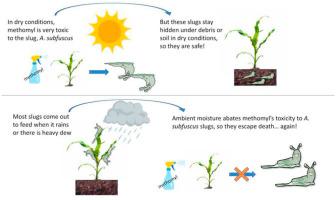Crop Protection ( IF 2.5 ) Pub Date : 2021-05-26 , DOI: 10.1016/j.cropro.2021.105709 Louis B. Nottingham , Thomas P. Kuhar

|
The carbamate insecticide methomyl is sometimes used to control slugs in field corn and soybean by foliar applications, but control outcomes in research trials and commercial operations have been mixed. In this study, laboratory bioassays were conducted on dusky slug, Arion subfuscus Müller, a common pest of corn and soybean in the Mid-Atlantic United States, to evaluate residual toxicity of Lannate LV (methomyl) at low and high concentrations corresponding to label recommended field rates, and if toxicity may be affected by ambient moisture or repellency to treated plants. Without wetting events, methomyl residues on corn plants caused 90–100% mortality of A. subfuscus for two days and 70–90% mortality for six days. When corn plants were briefly misted with ca. 0.3 cm of water 6 h after methomyl application, mortality was 36% 12 h after treatment, and 0 to 5% 24 h after treatment for both low and high rates. Repellency of A. subfuscus to corn plants treated with the high rate of methomyl was narrowly significant (P = 0.04) and low rate was not significant. These results suggest that high ambient moisture needed to elicit slug activity in the field also abates toxicity of methomyl residues, explaining why field control is usually poor despite high mortality in the lab.
中文翻译:

环境湿度导致玉米植物上的灭多威残留对害虫蛞蝓、Arion subfuscus、 Müller(Gastropoda、Stylommatophora)迅速失去毒性
氨基甲酸酯杀虫剂灭多威有时用于通过叶面喷洒控制大田玉米和大豆中的蛞蝓,但在研究试验和商业操作中的控制结果喜忧参半。在这项研究中,对美国中大西洋地区常见的玉米和大豆害虫Arion subfuscus Müller进行了实验室生物测定,以评估对应于标签推荐的低浓度和高浓度 Lannate LV(灭多威)的残留毒性田率,以及毒性是否可能受到环境湿度或对处理过的植物的排斥性的影响。如果没有润湿事件,玉米植株上的灭多威残留会导致A. subfuscus 90-100% 的死亡率2 天,6 天死亡率为 70-90%。当玉米植物被短暂地雾化时。灭多威施用 6 小时后 0.3 cm 水,处理后 12 小时的死亡率为 36%,处理后 24 小时的死亡率为 0% 至 5%,无论是低比率还是高比率。的排斥性A. subfuscus与灭多威率高处理玉米植物是狭显著(P = 0.04)和低速率不显著。这些结果表明,在田间引发蛞蝓活动所需的高环境湿度也会降低灭多威残留的毒性,这解释了为什么尽管实验室死亡率很高,但田间控制通常很差。











































 京公网安备 11010802027423号
京公网安备 11010802027423号